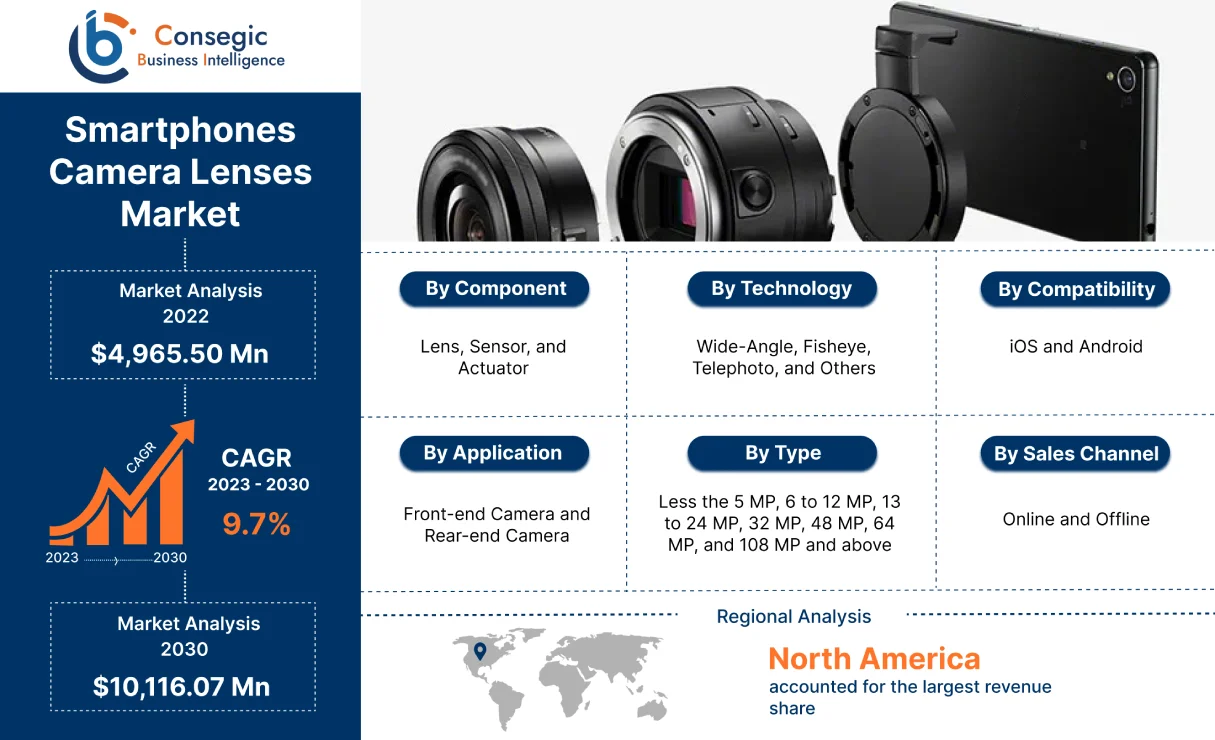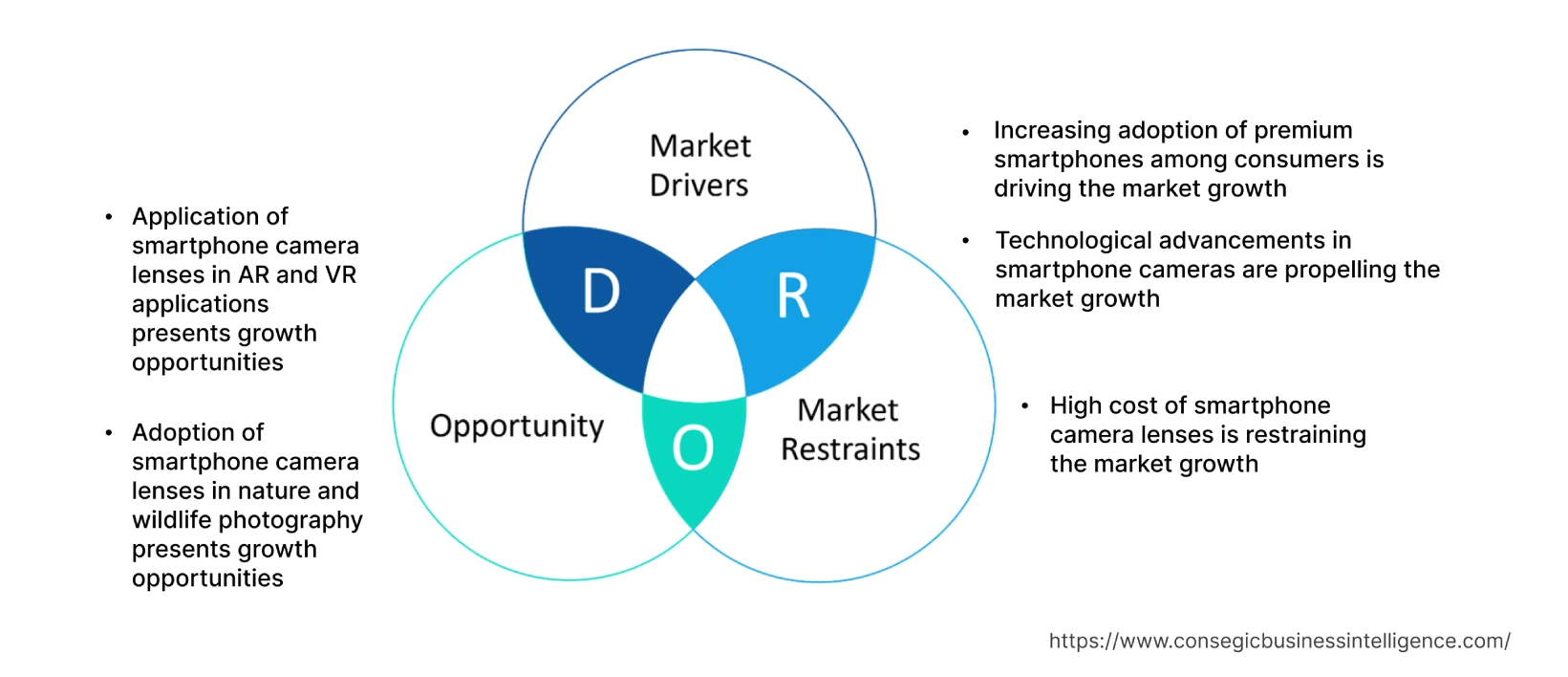Smartphones Camera Lenses Market Introduction :
Smartphones Camera Lenses Market is estimated to reach over USD 10,116.07 Million by 2030 from a value of USD 4,965.50 Million in 2022, growing at a CAGR of 9.7% from 2023 to 2030.
Smartphones Camera Lenses Market Definition & Overview:
A smartphone camera lens is an optical component of a camera system for capturing a different field of view. The camera lens plays a crucial role in determining the quality and characteristics of the photographs captured by a smartphone. Smartphones are equipped with multiple lenses to provide different shooting options including wide-angle, telephoto, fisheye, and others. Consequently, smartphones consist of high-resolution lenses to enhance the photography capabilities of an individual.
Smartphones Camera Lenses Market Insights :
Smartphones Camera Lenses Market Dynamics - (DRO) :
Key Drivers :
Increasing adoption of premium smartphones among consumers is driving the market growth
The increasing adoption of premium and high-priced smartphones among consumers is driving the growth of the market. Premium smartphones feature advanced camera systems with multiple lenses and large image sensors to improve the sharpness of images without changing shadows or colors. Consequently, manufacturers are investing in camera lenses with high-resolution capabilities to meet the expectations of the customers. For instance, in June 2023, Samsung introduced Galaxy F54 5G premium smartphone featuring 108MP no shake camera with 2 MP macro lens, 32 MP selfie camera, and 8 MP ultra-wide lens. Therefore, the increasing demand for high-quality cameras in smartphones is accelerating the growth of the market.
Technological advancements in smartphone cameras are propelling the market growth
The advancements in smartphone camera lens technology to provide excellent image quality, fast autofocus and striking HDR capabilities are driving the growth of the market. The growing demand for high-quality smartphone lenses featuring large pixel size and big optical formats has enabled smartphone OEMs to launch devices that deliver exceptional camera performance. Manufacturers are increasingly focusing on advanced technologies including dual conversion gain (DCG) technology to extend dynamic range and capture low-noise images in challenging light conditions. For instance, in January 2023, Omnivision launched a high-resolution 50-megapixel (MP) image sensor called OV50H featuring Dual Conversion Gain (DCG) technology to improve low-light and autofocus performance in high-end smartphones. Therefore, continuous advancements in smartphone camera technology are propelling the growth of the market.
Key Restraints :
High cost of smartphone camera lenses is restraining the market growth
High-quality camera lenses require precision optics and advanced materials to achieve optimal image quality. The application of specialized glass material, aspherical lenses, and advanced coatings is adding significantly to the overall cost of smartphone camera lenses. Moreover, the complex manufacturing processes of camera lenses to incorporate advanced features is further increasing the costs of smartphone lenses. Therefore, high manufacturing costs of camera lenses in smartphones is restraining the growth of the market.
Future Opportunities :
Application of smartphone camera lenses in AR and VR applications presents growth opportunities
The adoption of smartphone camera lenses in Augmented Reality (AR) and Virtual Reality (VR) applications to provide immersive and engaging experience to the users is expected to present potential opportunities for the market growth during the forecast period. The integration of AR and VR in smartphone cameras enables accurate object tracking and depth sensing of the objects. Consequently, the application of smartphone camera lenses in AR gaming is expected to drive the market growth during the forecast period.
Adoption of smartphone camera lenses in nature and wildlife photography presents growth opportunities
The application of smartphone camera lenses in nature and wildlife photography to capture wide angle images is expected to create growth opportunities for the market during the forecast period. The incorporation of Optical Image Stabilization (OIS) and autofocus feature in smartphones allows users to capture clear and sharp images by minimizing the blur effect caused by camera shakes. Moreover, the deployment of tripod stands to capture more immersive images is expected to drive the market growth during the forecast period.
Smartphones Camera Lenses Market Report Insights :
| Report Attributes | Report Details |
| Study Timeline | 2017-2030 |
| Market Size in 2030 | USD 10,116.07 Million |
| CAGR (2023-2030) | 9.7% |
| By Component | Lens, Sensor, and Actuator |
| By Type | Less than 5 MP, 6 to 12 MP, 13 to 24 MP, 32 MP, 48 MP, 64 MP, and 108 MP and above |
| By Technology | Wide-Angle, Fisheye, Telephoto, and Others |
| By Compatibility | iOS and Android |
| By Sales Channel | Online and Offline |
| By Application | Front-end Camera and Rear-end Camera |
| By Region | North America, Europe, Asia-Pacific, Latin America, and Middle East & Africa |
| Key Players | Largan Precision Co. Ltd., Sunny Optical Technology (Group) Company Limited, GeniuS Electronic Optical, SEKONIX Co., Ltd., Kantatsu Co., Ltd., Asia Optical Co., Inc., Ability Opto-Electronics Technology, Corning Incorporated, Omnivision |
Smartphones Camera Lenses Market Segmental Analysis :
Based on the Component :
Based on the component, the market is trifurcated into lens, sensor, and actuator. The lens segment accounted for the largest revenue share in the year 2022. The growing trend of photography among consumers is driving the growth of the market. Consumers are increasingly adopting smartphones with high-quality smartphone lenses to capture sharp and detailed images. Camera lenses are essential for capturing a larger field of view for landscape and group photo shoots. Moreover, the ability of smartphone camera lenses to provide bright light and zoom capabilities is accelerating the growth of the market.
The sensor segment is anticipated to witness the fastest CAGR growth during the forecast period. Sensors play a crucial role in smartphone cameras as they capture light for the formation of digital images. Sensors are used to determine the resolution of captured images in the form of pixels. As a result, manufacturers are focusing on producing high MP cameras to capture bright and detailed images. For instance, in April 2023, Xiaomi launched Xiaomi 13 Ultra featuring a quad camera system with 1-inch sensor and an ultra-grade WQHD+ display for excellent color accuracy. Therefore, the increasing demand for high-quality cameras in smartphones is propelling the growth of the market.
Based on the Type :
Based on the type, the market is segregated into less than 5 MP, 6 to 12 MP, 13 to 24 MP, 32 MP, 48 MP, 64 MP, and 108 MP and above. The 48 MP segment accounted for the largest revenue share in the year 2022. The high pixel count of 48 MP camera allows users to capture sharp and detailed images. Moreover, 48 MP camera allows individuals to capture images with live focus feature coupled with a natural blur effect in the background. For instance, in February 2022, Samsung launched Samsung's A-series called Galaxy A03 featuring a 48MP dual rear camera to capture sharp and detailed images. Furthermore, the ability of 48 MP camera to provide advanced zoom capabilities and enhanced performance is driving the growth of the market.
The 108 MP segment is expected to register the fastest CAGR growth during the forecast period. The ability of 108 MP smartphone camera to capture images similar to a DSLR camera is driving the growth of the market. Increasing pixel count in smartphone cameras provides exceptional detail and clarity in capturing images. Consequently, the 1080 MP cameras are well-suited for photography purposes to capture small details and fine textures. Thus, the application of 108 MP smartphone cameras to enhance photography skills is driving the growth of the market.
Based on the Technology :
Based on the technology, the market is segmented into wide-angle, fisheye, telephoto, and others. Wide-angle lens accounted for the largest revenue share of 47.7% in the year 2022. Wide-angle lenses have a shorter focal length compared to standard lenses, allowing for a wider field of view. Wide angle lenses are used in the front camera of smartphones. As a result, the lenses are ideal for day-to day photography activities. For instance, in May 2022, Sony Group Corporation launched new Xperia 1 IV smartphone featuring 24mm wide lens, 16mm ultra-wide lens, and 85-125mm telephoto lens to offer accurate focus, light exposure, and larger field of view for capturing high-quality content. Consequently, the rising trend of capturing selfies due to the increasing number of social media platforms is driving the growth of this segment.
The telephoto segment is projected to witness the fastest CAGR growth during the forecast period. Telephoto lenses have a longer focal length, enabling users to zoom camera for distant objects. Telephoto lenses offer a narrower field of view and are well-suited for capturing distant objects such as wildlife, landscape photography, and others. Moreover, the ability to customize telephoto lenses as they are available in both prime and zoom varieties is propelling the growth of the market.
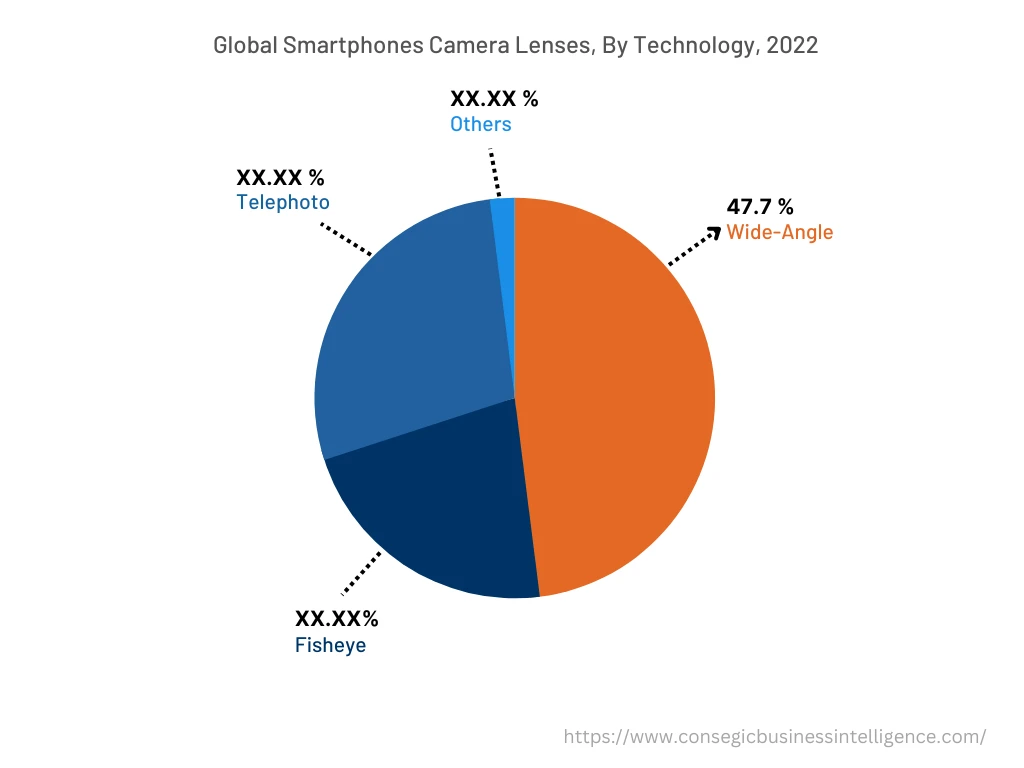
Based on the Compatibility :
Based on compatibility, the market is segmented into iOS and Android. The Android segment accounted for the largest revenue share in the year 2022. The cost-effectiveness and the ability to capture high-quality images with android smartphones is driving the growth of the market. Manufacturers are focusing on improving the image capturing capabilities of android smartphones. Consequently, android smartphone cameras are equipped with high quality ultra-wide and telephoto lenses to capture detailed images. Moreover, the affordability of android smartphones attract a large number of customers towards this segment, resulting in market growth.
The iOS segment is anticipated to emerge as the fastest-growing segment during the forecast period. iPhones have better lenses and higher-resolution sensors than in comparison to android smartphones for capturing high-quality images. Moreover, iPhones have the capability to capture sharp images with better color accuracy. For instance, in September 2022, Apple Inc. launched iPhone 14 and iPhone 14 Plus with a new dual-camera system featuring 12MP main camera for capturing photos and videos. Furthermore, the better zoom capacity of iPhones in comparison to android smartphones is contributing to the growth of smartphone camera lens market.
Based on the Sales Channel :
Based on the sales channel, the market is bifurcated into online and offline. The offline segment accounted for the largest revenue share in the year 2022 as smartphones with high-quality cameras are available in wide range of stores including specialty stores, electronics stores, and others. Moreover, mobile phone retailers have a separate section of camera accessories to attract a large customer base. Customers exhibit a preference for physical product testing before purchase, particularly for expensive items including smartphone camera lenses. Thus, offline stores provide the opportunity to understand product features and functionality, resulting in the growth of this segment.
The online segment is expected to emerge as the fastest growing segment during the forecast period. The growth of this segment is attributed to the shift in customer behavior of shopping online through e-commerce websites, online marketplaces, and mobile applications. Online sales channel provides an opportunity to the customers to compare prices of different models before purchasing. Furthermore, the facility of home delivery provided by online sales channel is contributing to the growth of smartphone camera lenses market.
Based on the Application :
Based on the application, the market is bifurcated into front-end camera and rear-end camera. The front-end camera accounted for the largest revenue share in the year 2022. Front-end cameras are located on the front side of the smartphone and are well-suited for capturing selfies and attending video calls. Front-facing cameras work by capturing light through a lens and converting it into an electrical signal using a sensor. Moreover, front-end cameras comprise of wide-angle lenses to capture a large view of the scene. Furthermore, front-end cameras are equipped with built-in beauty modes and filters to apply different effects on selfies and videos, thereby producing high-quality content.
The rear-end camera is anticipated to register the fastest CAGR growth during the forecast period. Rear-end camera lenses are located at the back of smartphones to offer high resolution, advanced features, and better image quality in comparison to the front-end cameras. Rear-end camera lenses incorporate Optical Image Stabilization (OIS) to capture sharp and smooth images and videos. Moreover, manufacturers are improving the low-light performance by employing large pixel size and night-mode features to capture images in low-light conditions.
Based on the Region :
The regional segment includes North America, Europe, Asia Pacific, Middle East and Africa, and Latin America.
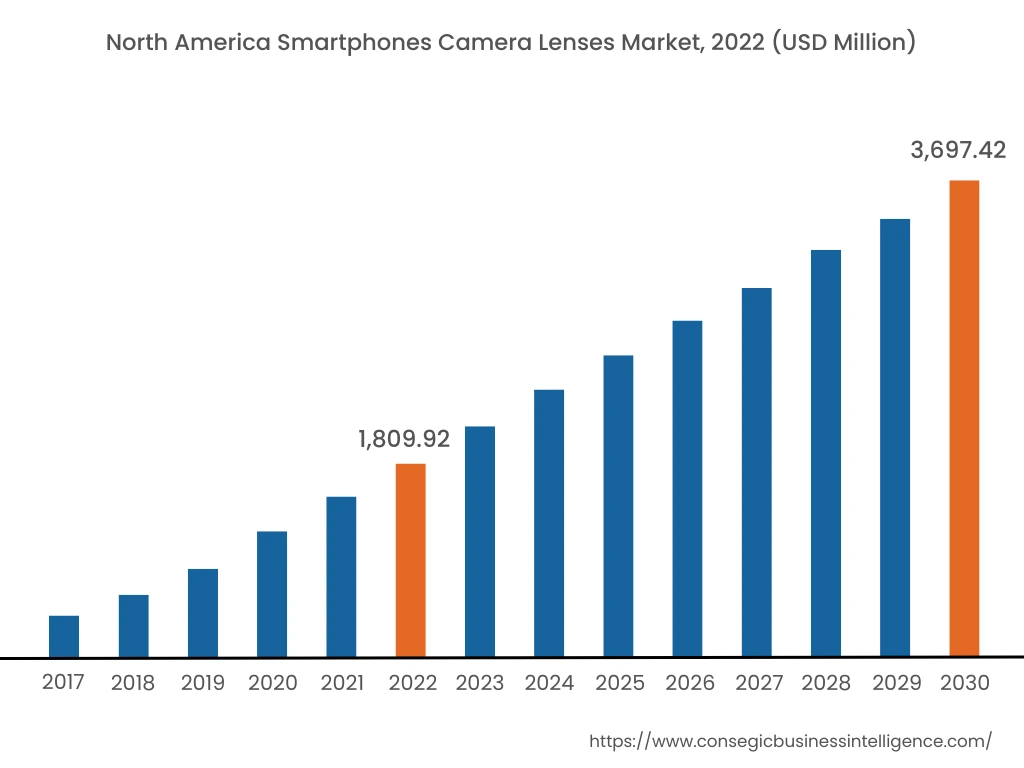
North America accounted for the largest revenue share of USD 1,809.92 million in 2022 and is expected to reach USD 3,697.42 million in 2030, registering a CAGR of 9.7%. Additionally, in the region, United States accounted for the largest revenue share of 48.65% in the year 2022. The increasing demand for consumer electronics such as smartphones, tablets, and other personal electronic devices is driving the growth of smartphones camera lenses market. Manufacturers are increasingly incorporating advanced image capturing capabilities into smartphones to enhance user experiences and offer more immersive content. Moreover, the technological advancements in the region are accelerating the growth of the market. Smartphones OEMs are investing heavily in improving the camera performance, image quality, and features to attract a large customer base towards smartphone cameras. Furthermore, the growing trend of photography in the region is accelerating the growth of the regional market.
The Asia-Pacific is anticipated to register the fastest CAGR growth of 10.0% during the forecast period. The growing popularity of social media platforms and selfie culture in Asia-Pacific region is driving the growth of the market. The active engagement of consumers in social media platforms is driving the demand for smartphones with advanced camera capabilities to capture high-quality selfies. Moreover, key players in the region are engaging in research & development activities for the production of high-performance camera lenses in the region. For instance, in March 2021, OnePlus collaborated with Hasselblad for three-years to develop the next generation of smartphone camera systems for OnePlus smartphone devices. Therefore, the presence of a large number of manufacturers in the region is propelling the growth of the regional market.
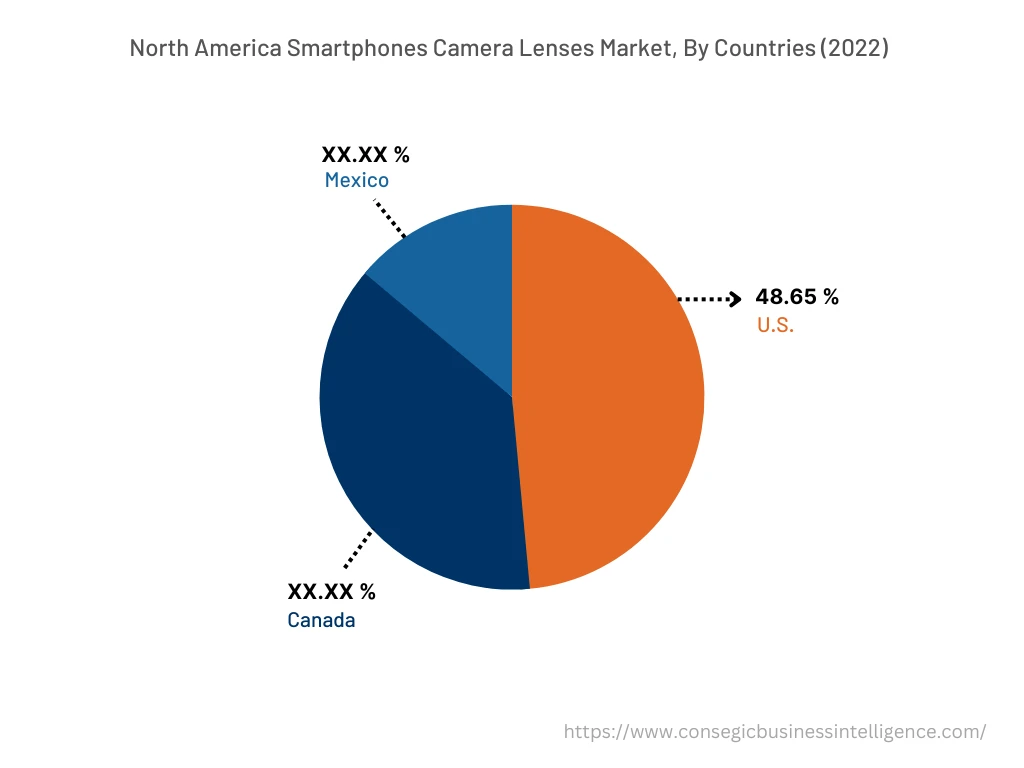
Top Key Players & Market Share Insights :
The smartphones camera lenses market is characterized by the presence of major players providing high-quality cameras in smartphones with advanced features. Key players are adopting several strategies in research and development, product innovation, and various business strategies, and application launches that accelerate the growth of the smartphone's camera lenses market. Key players in the market include-
- Largan Precision Co. Ltd.
- Sunny Optical Technology (Group) Company Limited
- Ability Opto-Electronics Technology
- Corning Incorporated
- Omnivision
- GeniuS Electronic Optical
- SEKONIX Co., Ltd.
- Kantatsu Co., Ltd.
- Asia Optical Co., Inc.
Recent Industry Developments :
- In July 2021, Corning Incorporated introduced scratch-resistant and durable glass composite products for mobile device cameras to offer advanced optical performance, durability, and superior scratch resistance.
- In December 2020, vivo Mobile Communication Co., Ltd. entered into a partnership with ZEISS to develop innovations in mobile imaging technology to be featured in vivo X60 series.
Key Questions Answered in the Report
What are smartphones camera lenses? +
Smartphones camera lenses are the optical devices in smartphones used for capturing high-quality, high-resolution images.
What specific segmentation details are covered in the smartphone’s camera lenses report, and how is the dominating segment impacting the market growth? +
The report consists of segments including component, type, technology, compatibility, sales channel, and application. Each segment has key dominating sub-segment being driven by the industry trends and market dynamics. For instance, by compatibility segment has witnessed android as the dominating segment in the year 2022, due to cost-effectiveness of android smartphones and lenses.
What specific segmentation details are covered in the smartphone’s camera lenses market report, and how is the fastest segment anticipated to impact the market growth? +
By sales channel segment has witnessed online as the fastest-growing segment during the forecast period due to rising trend of e-commerce websites among consumers.
Which region/country is anticipated to witness the highest CAGR during the forecast period, 2023-2030? +
Asia-Pacific region is expected to register fastest CAGR growth during the forecast period due to the rising trend of social media platforms in the region.
